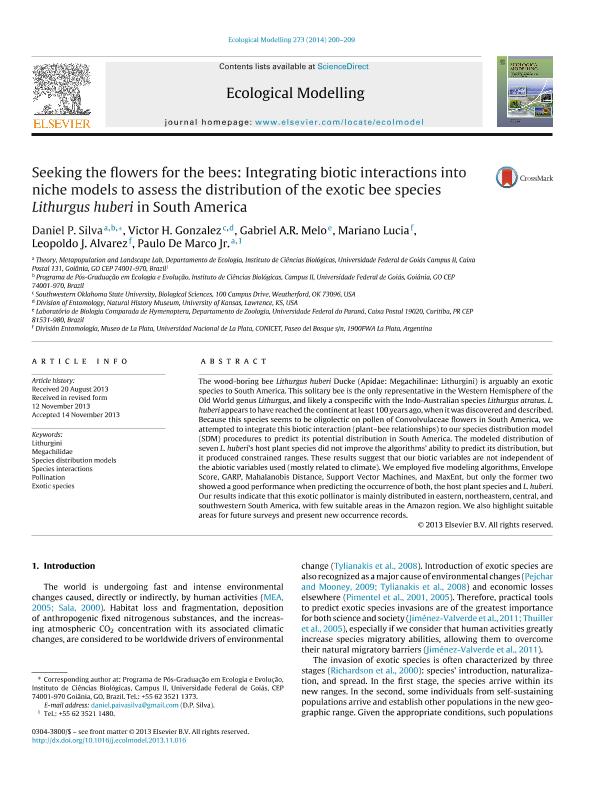Artículo
Seeking the flowers for the bees: Integrating biotic interactions into niche models to assess the distribution of the exotic bee species Lithurgus huberi in South America
Silva, Daniel P.; Gonzalez, Victor H.; Melo, Gabriel A. R.; Lucia, Mariano ; Alvarez, Leopoldo Jesús
; Alvarez, Leopoldo Jesús ; De Marco Jr., Paulo
; De Marco Jr., Paulo
 ; Alvarez, Leopoldo Jesús
; Alvarez, Leopoldo Jesús ; De Marco Jr., Paulo
; De Marco Jr., Paulo
Fecha de publicación:
02/2014
Editorial:
Elsevier
Revista:
Ecological Modelling
ISSN:
0304-3800
Idioma:
Inglés
Tipo de recurso:
Artículo publicado
Clasificación temática:
Resumen
The wood-boring bee Lithurgus huberi Ducke (Apidae: Megachilinae: Lithurgini) is arguably an exotic species to South America. This solitary bee is the only representative in the Western Hemisphere of the Old World genus Lithurgus, and likely a conspecific with the Indo-Australian species Lithurgus atratus. L.huberi appears to have reached the continent at least 100 years ago, when it was discovered and described. Because this species seems to be oligolectic on pollen of Convolvulaceae flowers in South America, weattempted to integrate this biotic interaction (plant bee relationships) to our species distribution model(SDM) procedures to predict its potential distribution in South America. The modeled distribution ofseven L. huberi is host plant species did not improve the algorithms ability to predict its distribution, butit produced constrained ranges. These results suggest that our biotic variables are not independent ofthe abiotic variables used (mostly related to climate). We employed five modeling algorithms, EnvelopeScore, GARP, Mahalanobis Distance, Support Vector Machines, and MaxEnt, but only the former twoshowed a good performance when predicting the occurrence of both, the host plant species and L. huberi.Our results indicate that this exotic pollinator is mainly distributed in eastern, northeastern, central, andsouthwestern South America, with few suitable areas in the Amazon region. We also highlight suitableareas for future surveys and present new occurrence records.
Archivos asociados
Licencia
Identificadores
Colecciones
Articulos(CCT - LA PLATA)
Articulos de CTRO.CIENTIFICO TECNOL.CONICET - LA PLATA
Articulos de CTRO.CIENTIFICO TECNOL.CONICET - LA PLATA
Citación
Alvarez, Leopoldo Jesús; Lucia, Mariano; Melo, Gabriel A. R.; Gonzalez, Victor H.; Silva, Daniel P.; De Marco Jr., Paulo; et al.; Seeking the flowers for the bees: Integrating biotic interactions into niche models to assess the distribution of the exotic bee species Lithurgus huberi in South America; Elsevier; Ecological Modelling; 273; 2-2014; 200-209
Compartir
Altmétricas



